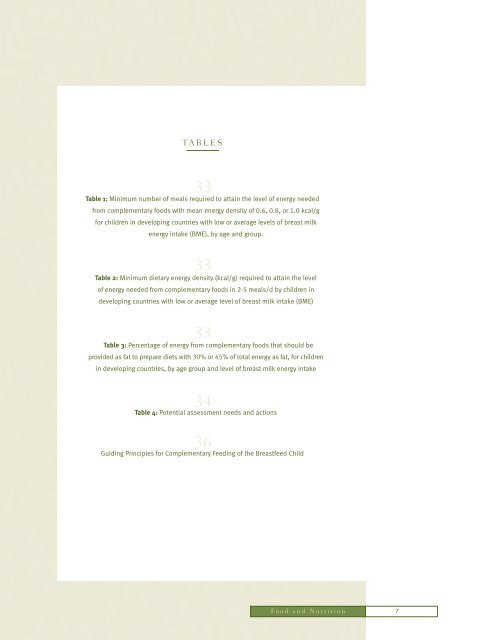Guiding Principles for Complementary Feeding of the Breastfed
Guiding Principles for Complementary Feeding of the Breastfed
Guiding Principles for Complementary Feeding of the Breastfed
You also want an ePaper? Increase the reach of your titles
YUMPU automatically turns print PDFs into web optimized ePapers that Google loves.
TABLES<br />
33<br />
Table 1: Minimum number <strong>of</strong> meals required to attain <strong>the</strong> level <strong>of</strong> energy needed<br />
from complementary foods with mean energy density <strong>of</strong> 0.6, 0.8, or 1.0 kcal/g<br />
<strong>for</strong> children in developing countries with low or average levels <strong>of</strong> breast milk<br />
energy intake (BME), by age and group.<br />
33<br />
Table 2: Minimum dietary energy density (kcal/g) required to attain <strong>the</strong> level<br />
<strong>of</strong> energy needed from complementary foods in 2-5 meals/d by children in<br />
developing countries with low or average level <strong>of</strong> breast milk intake (BME)<br />
33<br />
Table 3: Percentage <strong>of</strong> energy from complementary foods that should be<br />
provided as fat to prepare diets with 30% or 45% <strong>of</strong> total energy as fat, <strong>for</strong> children<br />
in developing countries, by age group and level <strong>of</strong> breast milk energy intake<br />
34<br />
Table 4: Potential assessment needs and actions<br />
36<br />
<strong>Guiding</strong> <strong>Principles</strong> <strong>for</strong> <strong>Complementary</strong> <strong>Feeding</strong> <strong>of</strong> <strong>the</strong> Breastfeed Child<br />
Food and Nutrition<br />
7

















